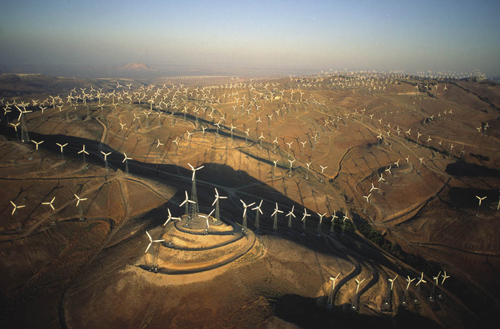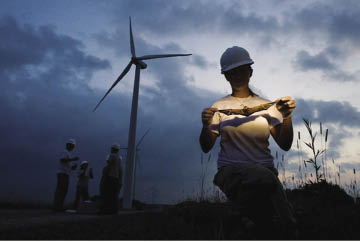 Tommy Molioo • Biologist • FirstCarbon Solutions • www.firstcarbonsolutions.com
Tommy Molioo • Biologist • FirstCarbon Solutions • www.firstcarbonsolutions.com
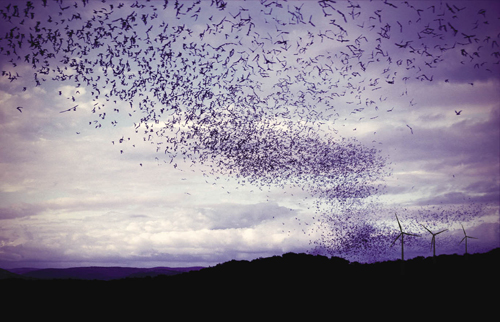 Unfortunately, the wind industry does not yet have a handle on the issue of the rising bat mortality rate. Researchers initially believed bat deaths at wind farms were the same as birds, but autopsies have revealed a more complex situation. Currently, there is no quick fix to completely end bat fatalities, but understanding bat migration and roosting can lessen impacts.
Unfortunately, the wind industry does not yet have a handle on the issue of the rising bat mortality rate. Researchers initially believed bat deaths at wind farms were the same as birds, but autopsies have revealed a more complex situation. Currently, there is no quick fix to completely end bat fatalities, but understanding bat migration and roosting can lessen impacts.
Bats play a vital role in the earth’s ecosystems. Bats probably save farmers billions because they act as pollinators for various plants and remove pests from agricultural areas. The recent interest in creating more energy from wind has increased the impacts between bats and wind farms in the United States, Canada, and Europe. Biologists have been working with state and federal agencies to determine the cause of bat deaths at wind farms and find a solution. The United States Fish and Wildlife Service and state agencies such as the California Department of Fish and Wildlife have published voluntary guidelines for conducting surveys at potential and existing wind farm facilities.
Bats are as susceptible as birds and other wildlife species to impacts related to wind energy development. In fact, the California Energy Commission has published the California Guidelines for Reducing Impacts to Birds and Bats from Wind Energy Development
(http://www.energy.ca.gov/windguidelines/) to help reduce potential project impacts. As awareness grows and biologists conduct more research, they will find ways to limit future impacts. Increased awareness and proper site design can help reduce potential impacts to bats and keep these furry little insect vacuums cleaning our skies and fields.
An introduction to bats
Many people do not know that bats can fly as high as birds. The hoary bat, for instance, has been observed flying as high as 8,000 feet. Although one will not typically find bats flying thousands of feet in the air, they can fly as high as most wind turbines, particularly bats that roost in trees. Wind turbines are typically placed on ridges and the edge of hills and valleys, which creates potential impact locations. Bats will inhabit any area that has plenty of food and cover for day and night roosts and many sites suited for renewable energy development have these factors. Wind-farm facilities are often placed in undisturbed areas along valleys and foothills for optimum wind-power generation.
For tree-roosting bats, the best sites include areas with dense foliage, often near water, and with an ample supply of insects. Most of the time this includes riparian areas, those along rivers and streams with emergent wetland vegetation, such as willow and cottonwood trees. The tall and often dense canopy observed in many riparian forests provide suitable roosting and foraging habitat for bats that typically fly and forage on open-air insects and on trees, as opposed to gleaning insects close to water. The three species of bats most affected by wind-energy development in the United States are the hoary bat, silver-haired bat, and eastern red bat.
All three species are observable throughout the United States, although the eastern red bat generally does not reside west of Texas. These species roost in trees, forage for insects in the air, and have been known to fly in the late afternoon in warm summer months. Additionally, the silver-haired bat is one of the slowest flying bats in North America. FirstCarbon Solutions biologists are now beginning to understand why these bats have the highest death toll at wind-farm facilities.
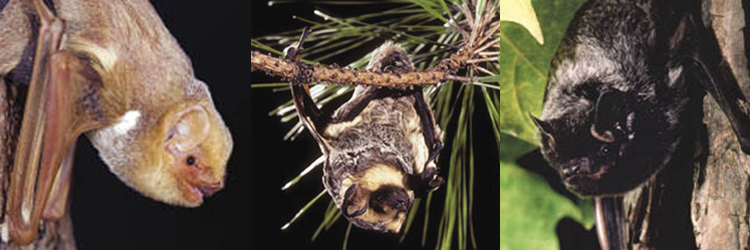
From left to right: Eastern red bat (Lasiurus borealis), Hoary bat (Lasiurus cinereus), and Silver-haired bat (Lasionycteris noctivagans)
How do wind turbines cause bat deaths?
Originally, the main focus and concern for wildlife affected by wind turbines was reducing impacts to bird species, particularly the fully protected golden eagle. Studies to gather turbine strike mortality data for birds at existing wind-farm facilities began to show an unexpected number of bat carcasses present near the base of wind turbines. Biologists initially assumed that bats, like birds, were striking turbine blades. As more data is gathered at wind-farm facilities across North America and Europe, the cause of the problem appears to be something else.
Research suggests most bat deaths occur during autumn migrations when many first-year bats are beginning to take flight and older bats are migrating through an unfamiliar area. Unlike birds that fly into wind turbine blades or the turbine itself, the primary cause of death for bats appears to be attributed to the decompression hypothesis. It proposes that bats are killed by barotrauma, which results when a flying bat enters the vortex created by spinning turbine blades, which creates negative or low-pressure pockets. When a bat flies through a pocket of low pressure, higher pressure in the lung causes pulmonary barotrauma. Bat lungs essentially explode as their air sacs over expand and surrounding capillaries burst. Most autopsied bats showed evidence of internal hemorrhaging and only minor external injuries to wings, the cause of which comes most likely from impacting the ground. Lesions were observed on the lungs where hemorrhaging occurred.
Bats’ sophisticated echolocation lets them navigate better by sound than with their eyes, so many researchers were initially puzzled as to what was causing bat deaths, assuming they should be able to avoid such large structures. In fact, even if bats’ echolocation lets them avoid turbines and blades, they may first be incapacitated or killed by internal injuries caused by rapid pressure reduction before they have the chance to avoid the turbine. Barotrauma is observed more often in bats than birds. The unique respiratory anatomy of birds makes them less susceptible to barotrauma. Bats’ large, pliable lungs expand when exposed to a sudden drop in external pressure, causing tissue damage, whereas birds’ compact, rigid lungs do not expand.
What can be done to reduce or prevent wind-turbine related fatalities to bats?
As renewable energy development, particularly wind energy, continues throughout the United States, Canada, and Europe, wildlife protection is becoming a high priority. Initial concerns were focused on protecting bird species and mitigation measures to reduce bird deaths have so far been relatively successful. However, bat mortalities have increased to the number of bird mortalities revealing a need for additional protection measures.
Biologists throughout North America and Europe are conducting long-term monitoring studies at various wind farms to determine the prime conditions for potential bat mortalities. Studies have determined a correlation between the migrating period for bats, between summer and fall, and observed bat carcasses at wind-farm facilities. Conducting a multi-season or yearlong survey at a wind farm, before and after construction, can determine what bat species are onsite and which species migrate through the site. The results help determine the time of year for the most bat fatalities.
Field experiments are also being conducted to alter when turbine rotors begin spinning in low winds. Letting wind turbines spin only at optimal power-generating speeds can potentially save bats by reducing the potential for pressure changes and limiting turbine operation from periods when bats are most active – at dawn and dusk. While this process may be successful in reducing bat fatalities, more research and results are needed to determine if this option is viable and feasible to use on a large scale.
Potential measures to reduce bat mortalities are still fairly new. A few include emitting an electromagnetic field around wind turbines to reduce bat activity, broadcasting high frequency bat calls to deter them from entering the area around turbines, and shutting down turbines at dawn and dusk when bats are most active.
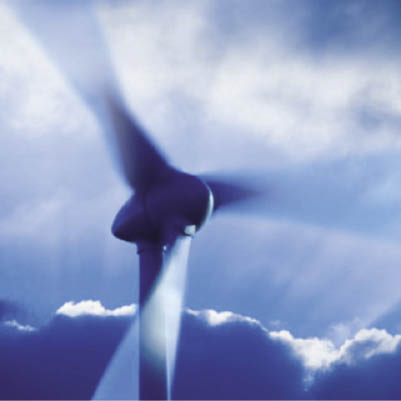
Field experiments of one solution have begun to alter when turbine blades begin to spin, ideally when bats are least active.
While these hypothesized protection measures sound like good ideas, they need more research to show an acceptable success rate. Small-scale tests using electromagnetic fields to deter bats have shown positive results. Ultrasonic broadcasts may be useful in deterring bats from an area, and increasing the amplitude of the broadcasted sound may increase its effectiveness and range. Broadcasting high frequency bat calls may also prove successful to deter them. The initial tests, however, broadcasted a bat social call, which only drew more bats into the area, instead of repelling them. Currently, the best way to reduce a potential impact of any project, particularly wind-energy development, is proper up-front analysis and correct project design.
Other ideas for reducing impacts to bats revolve around the current designs and technology used in wind turbines. A potential solution may be a wind turbine that does not have spinning blades so it does not create a low-pressure vortex. New designs and advanced technology developed in a cost-effective manner may one day help eliminate all impacts to bats and birds alike. WPE
For further reading
Baerwald et al. “Barotrauma is a significant cause of bat fatalities at wind turbines” Current Biology Vol. 18 No. 16.
Filed Under: Featured, News

